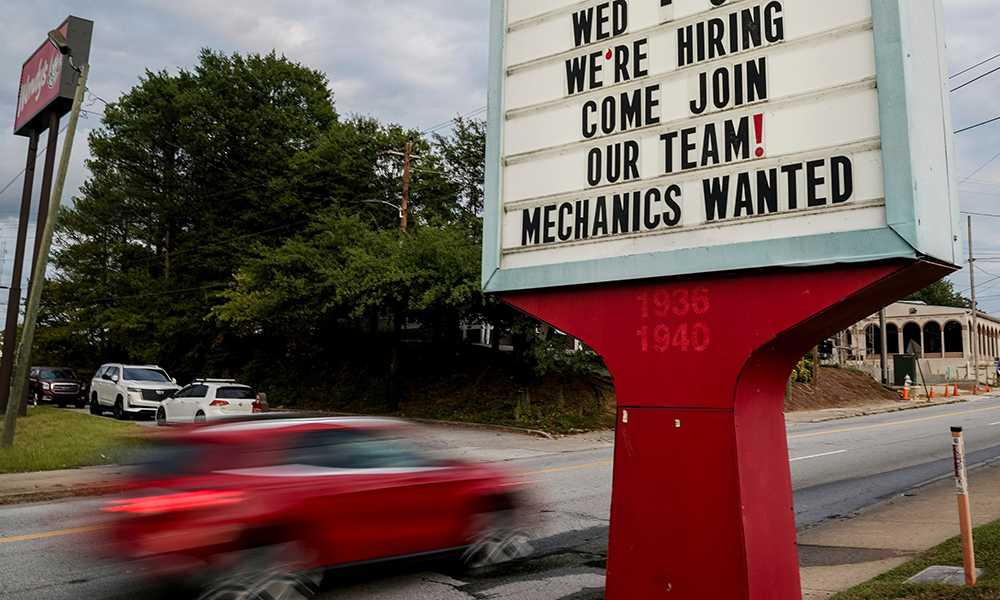
上周三,美联储自2020年3月以来首次降息。股市起初并不接受这一举措,美国三大股指在震荡交易后均收跌。
至关重要的是,虽然不能对单日股市波动进行过多解读,但投资者对上周三股市剧烈波动的担心主要有以下几点。
首先,美联储决定大幅降息50个基点,而不是更常见的25个基点,这被一些人视为央行“落后于曲线”的证据——这意味着央行本应在几个月前就降息以刺激经济。
其次,美联储对2025年底前降息的预期较为温和,远低于投资者对持续大幅降息的预期,这可能令一些市场参与者感到恐慌,他们担心高利率会导致经济过快放缓。
然而,上周四,投资者的担忧似乎得到了缓解。随着初请失业金人数降至5月以来的最低水平,制造业调查显示该行业的韧性强于预期,一项关键的薪资指标上升,美国经济看起来相对强劲。
亚德尼研究公司(Yardeni Research)首席市场策略师里克·沃勒斯坦(Eric Wallerstein)说,事实上,美联储看起来一点也不落后于曲线。
“如果美联储和市场因为历史押着同样的韵脚或重演而极度担心失业问题……如果这是我们的主要担忧。我们刚得到的数据显示,实际上,制造业已经在自行改善,失业率数据是自夏季以来最好的,美联储降息50个基点,我们正在实现某种形式的涅槃,对吧?”他告诉《财富》杂志。“美联储正在削弱我们多年来见过的最强经济体之一。”
三大迹象表明美国经济具有惊人的韧性
初请失业金人数
长期以来,投资者一直担心持续的高利率会导致经济放缓,最终引发一连串的裁员潮。随着申请失业救济人数稳步上升,他们一度有证据支持自己的理论。
但上周情况有所不同。截至9月14日当周初请失业金人数(衡量裁员的最佳指标之一)为21.9万人。这是自5月份以来的最低水平,低于之前的23.1万。
与此同时,失业人数缩减至6月初以来的水平。截至9月7日的当周,投保失业人数,即积极领取失业救济金的人数,减少了1.4万人,降至182.9万人。
摩根士丹利(Morgan Stanley)E*TRADE和投资董事总经理克里斯·拉金(Chris Larkin)通过电子邮件向《财富》杂志透露了上述数据:“自‘大幅’降息以来的首个经济数据,应该会让美联储感到满意。申请失业救济金人数低于预期不会立即引发人们对劳动力市场过度放缓的担忧。”
沃勒斯坦也赞同这一观点。“每周初请失业金人数和续请失业救济金人数都在下降……人们担心失业率会继续攀升。事实并非如此。裁员数据没有显示出经济放缓或衰退的迹象。”
制造业调查
多年来,美国经济的制造业一直在处理令人头疼的问题,从疫情时期的供应链中断到劳动力成本上升。由于该行业通常被视为衡量经济健康状况的风向标,制造业的活动疲软引发了一些人对美国经济增长持久性的担忧。
不过,最近这些担忧似乎再次有所缓和。上周四,费城联邦储备银行制造业商业前景调查(衡量特拉华州、新泽西州南部、宾夕法尼亚州中部和东部制造业活动的指标)扭转了夏季的下滑趋势,转为积极。
此前,纽约联邦储备银行上周一公布的纽约帝国制造业指数显示,该地区的商业活动在一年多以来首次出现增长。亚德尼研究公司的沃勒斯坦指出,对那些担心经济疲软或美联储落后于曲线的看跌投资者来说,多项制造业调查中的“活动改善”都是好迹象。
工资增长
在从2022年初9.3%的峰值持续下降到今年5月的3.1%之后,工资增长也可能最终出现转机。Indeed的工资追踪器(Wage Tracker)显示,8月份公布的工资增长了3.3%,该公司称这是“广泛的”企稳。
Indeed经济学家尼克·邦克(Nick Bunker)和艾莉森·施里瓦斯塔瓦(Allison Shrivastava)在评论该数据时写道:“简而言之,随着公布的工资以与疫情前同样稳定和可持续的速度增长,Indeed工资追踪器显示,美国劳动力市场可能正步入正轨。”
亚德尼研究公司的沃勒斯坦再次指出,这一数据是经济增长的良好信号,诚然也有助于缓解投资者对劳动力市场恶化的担忧。他说:“实际工资在上涨,跑赢了通胀,[消费者]也在进行消费。”
稳定的工资增长、制造业的韧性以及缺乏裁员激增的证据,都让沃勒斯坦相信,市场可以继续上涨,尽管会出现一些间歇性的波动。他表示:“只要经济增长强于预期,你就无需担心。”(财富中文网)
译者:中慧言-王芳
上周三,美联储自2020年3月以来首次降息。股市起初并不接受这一举措,美国三大股指在震荡交易后均收跌。
至关重要的是,虽然不能对单日股市波动进行过多解读,但投资者对上周三股市剧烈波动的担心主要有以下几点。
首先,美联储决定大幅降息50个基点,而不是更常见的25个基点,这被一些人视为央行“落后于曲线”的证据——这意味着央行本应在几个月前就降息以刺激经济。
其次,美联储对2025年底前降息的预期较为温和,远低于投资者对持续大幅降息的预期,这可能令一些市场参与者感到恐慌,他们担心高利率会导致经济过快放缓。
然而,上周四,投资者的担忧似乎得到了缓解。随着初请失业金人数降至5月以来的最低水平,制造业调查显示该行业的韧性强于预期,一项关键的薪资指标上升,美国经济看起来相对强劲。
亚德尼研究公司(Yardeni Research)首席市场策略师里克·沃勒斯坦(Eric Wallerstein)说,事实上,美联储看起来一点也不落后于曲线。
“如果美联储和市场因为历史押着同样的韵脚或重演而极度担心失业问题……如果这是我们的主要担忧。我们刚得到的数据显示,实际上,制造业已经在自行改善,失业率数据是自夏季以来最好的,美联储降息50个基点,我们正在实现某种形式的涅槃,对吧?”他告诉《财富》杂志。“美联储正在削弱我们多年来见过的最强经济体之一。”
三大迹象表明美国经济具有惊人的韧性
初请失业金人数
长期以来,投资者一直担心持续的高利率会导致经济放缓,最终引发一连串的裁员潮。随着申请失业救济人数稳步上升,他们一度有证据支持自己的理论。
但上周情况有所不同。截至9月14日当周初请失业金人数(衡量裁员的最佳指标之一)为21.9万人。这是自5月份以来的最低水平,低于之前的23.1万。
与此同时,失业人数缩减至6月初以来的水平。截至9月7日的当周,投保失业人数,即积极领取失业救济金的人数,减少了1.4万人,降至182.9万人。
摩根士丹利(Morgan Stanley)E*TRADE和投资董事总经理克里斯·拉金(Chris Larkin)通过电子邮件向《财富》杂志透露了上述数据:“自‘大幅’降息以来的首个经济数据,应该会让美联储感到满意。申请失业救济金人数低于预期不会立即引发人们对劳动力市场过度放缓的担忧。”
沃勒斯坦也赞同这一观点。“每周初请失业金人数和续请失业救济金人数都在下降……人们担心失业率会继续攀升。事实并非如此。裁员数据没有显示出经济放缓或衰退的迹象。”
制造业调查
多年来,美国经济的制造业一直在处理令人头疼的问题,从疫情时期的供应链中断到劳动力成本上升。由于该行业通常被视为衡量经济健康状况的风向标,制造业的活动疲软引发了一些人对美国经济增长持久性的担忧。
不过,最近这些担忧似乎再次有所缓和。上周四,费城联邦储备银行制造业商业前景调查(衡量特拉华州、新泽西州南部、宾夕法尼亚州中部和东部制造业活动的指标)扭转了夏季的下滑趋势,转为积极。
此前,纽约联邦储备银行上周一公布的纽约帝国制造业指数显示,该地区的商业活动在一年多以来首次出现增长。亚德尼研究公司的沃勒斯坦指出,对那些担心经济疲软或美联储落后于曲线的看跌投资者来说,多项制造业调查中的“活动改善”都是好迹象。
工资增长
在从2022年初9.3%的峰值持续下降到今年5月的3.1%之后,工资增长也可能最终出现转机。Indeed的工资追踪器(Wage Tracker)显示,8月份公布的工资增长了3.3%,该公司称这是“广泛的”企稳。
Indeed经济学家尼克·邦克(Nick Bunker)和艾莉森·施里瓦斯塔瓦(Allison Shrivastava)在评论该数据时写道:“简而言之,随着公布的工资以与疫情前同样稳定和可持续的速度增长,Indeed工资追踪器显示,美国劳动力市场可能正步入正轨。”
亚德尼研究公司的沃勒斯坦再次指出,这一数据是经济增长的良好信号,诚然也有助于缓解投资者对劳动力市场恶化的担忧。他说:“实际工资在上涨,跑赢了通胀,[消费者]也在进行消费。”
稳定的工资增长、制造业的韧性以及缺乏裁员激增的证据,都让沃勒斯坦相信,市场可以继续上涨,尽管会出现一些间歇性的波动。他表示:“只要经济增长强于预期,你就无需担心。"”(财富中文网)
译者:中慧言-王芳
The Federal Reserve cut interest rates for the first time since March 2020 on Wednesday. Stocks balked at the move initially, with all three major U.S. market indices ending the day in the red after a volatile trading session.
While it’s important not to read too far into single-day stock market gyrations, there were a few key investor fears blamed for Wednesday’s wild ride.
First, the Fed’s decision to opt for an outsized 50 basis point rate cut, instead of the more common 25 basis points, was seen by some as evidence that the central bank is “behind the curve”—meaning it should have cut rates months ago to stimulate the economy.
Second, the Fed’s more modest projections for interest rate cuts through the end of 2025—which were well below investors’ expectations for ongoing, aggressive cuts—may have spooked some market participants who fear high rates are slowing the economy too quickly.
On Thursday, however, investors’ fears seemed to have been assuaged. With initial jobless claims falling to their lowest level since May, manufacturing surveys demonstrating more resilience in that sector than anticipated, and a key wage tracker rising, the economy is looking relatively robust.
In fact, the Fed doesn’t look behind the curve at all, according to Eric Wallerstein, chief markets strategist at Yardeni Research.
“If the Fed and the market are extremely worried about unemployment because history rhymes or repeats…if that’s our main worry. And then we got data this morning showing, actually, the manufacturing sector is already improving on its own, unemployment data is the best since before the summer, and the Fed cut 50 basis points, you’re getting a kind of Nirvana, right?” he told Fortune. “The Fed is cutting into one of the stronger economies we’ve seen in years”
3 signs of a surprisingly resilient U.S. economy
Initial jobless claims
Investors have long feared that a sustained period of elevated interest rates will slow the economy, and eventually spark a string of layoffs. And for a time, they had some evidence to back their theory, with jobless claims steadily rising.
But this week was different. Initial jobless claims, one of the best measures of layoffs, came in at 219,000 for the week ending September 14. That’s the lowest level since May, and down from 231,000 the prior week.
Meanwhile, unemployment rolls shrunk to levels last seen in early June. Insured unemployment, or the number of people actively receiving unemployment benefits, dropped 14,000 to 1,829,000 for the week ending September 7.
“The first economic data point since the ‘jumbo’ rate cut should please the Fed,” Chris Larkin, managing director of trading and investing at E*TRADE from Morgan Stanley, told Fortune of the data via email. “Lower-than-expected jobless claims won’t raise any immediate concerns about the labor market slowing too much.”
Wallerstein echoed that view. “Initial weekly [jobless] claims and continuing [jobless] claims now are falling…people were worried the climb would continue. That’s not the case. There’s no slow down, recession evidence in the layoff data.”
Manufacturing surveys
The manufacturing sector of the U.S. economy has dealt with headaches for years, from COVID-era supply chain disruptions to rising labor costs. With the sector often seen as a gauge of the economy’s health, weak activity has led to some concerns about the durability of U.S. economic growth.
But, once again, those fears seem to have been tempered of late. On Thursday, the Philadelphia Federal Reserve Manufacturing Business Outlook Survey—a gauge of activity in the manufacturing sector in Delaware, southern New Jersey and central and eastern Pennsylvania—turned positive, bucking its summer downtrend.
This comes after the New York Federal Reserve’s Empire State Manufacturing Survey showed business activity growth in that region for the first time in more than a year on Monday. Yardeni Research’s Wallerstein noted this “improving activity” in multiple manufacturing surveys is a good sign for any bearish investors that were concerned about economic weakness, or the Fed being behind the curve.
Wage growth
After falling consistently from a peak of 9.3% at the start of 2022 to just 3.1% in May of this year, wage growth may also finally be turning the corner. Indeed’s Wage Tracker shows posted wages rose 3.3% in August in what the company labeled a “broad-based” stabilization.
“In short, with posted wages growing at the same steady and sustainable pace we saw before the pandemic, the Indeed Wage Tracker is signaling the U.S. labor market may be settling into a groove,” Indeed economists Nick Bunker and Allison Shrivastava wrote of the data.
Yardeni’s Research’s Wallerstein argued, once again, this data is a good sign for economic growth, and certainly helps assuage investor fears about a deteriorating labor market. “Real wages are rising, beating inflation, and [consumers] are spending,” he said.
Steady wage growth, manufacturing resilience and the lack of evidence of a layoff spike all give Wallerstein confidence that markets can continue their rise, with some intermittent volatility. “As long as the economy is growing stronger than expected, you don’t need to worry,” he said.






